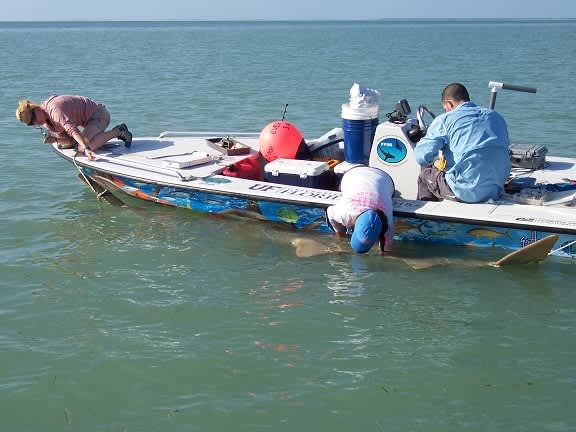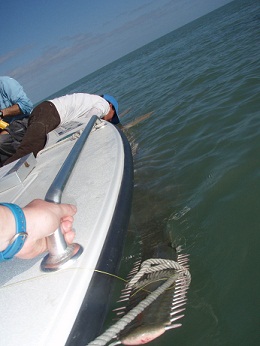Guy Harvey Ocean Foundation Supports Sawfish Studies around Florida
OutdoorHub 09.12.11

Fort Lauderdale, FL. SEPT. 13, 2011—Also known as the Carpenter Shark, Sawfish are a family of rays, characterized by a long, toothy nose extension. Several species can grow to approximately 7 meters or 23 feet. The family as a whole is largely unknown and little studied—until now.
In October 2010, the Guy Harvey Ocean Foundation and Hell’s Bay Boatworks donated a custom boat and trailer, valued at more than $50,000, to the Florida Program for Shark Research. FPSR Director and world-renowned shark expert George Burgess recently filed this report detailing the ongoing sawfish studies he is conducting in the waters around South Florida:
During the spring sampling season, three ongoing projects of the Florida Program for Shark Research at UF’s Florida Museum of Natural History, one in collaboration with researchers from Florida State University (FSU), focused on the distribution and movements of adult and subadult sawfishes in the southern portion of its Florida range.

We produced a survey of the waters surrounding U.S. Navy properties in the Key West region in order to determine the current status of sawfishes in those areas for the U.S. Navy/U.S. Army Corps of Engineers. Because of obvious security constraints, we were the first fish biologists to sample in these waters in decades.
Concurrently, in conjunction with Dean Grubbs and fellow FSU scientists and the John Carlson of the National Marine Fisheries Service, we sampled the middle and lower Keys and Tortugas region and Florida Bay, catching and satellite tagging eleven sawfishes. Satellite tags give long time and distance of movement information and we hope our tagging will help us better understand seasonal horizontal (up and down the coast) and vertical (depth) movements of the critters.
We also caught and multiple tagged two large adults in Florida Bay, the tags being traditional “spaghetti,” satellite, and active acoustic models. The last allowed us to manually track the minute-to-minute movements using a receiver held under the boat. Our first saw was “lost” within the first hour or so as it gave us the slip by scooting over a shallow bank, then boogying before we could detect its signal. Having learned our lesson, on our second capture we got in 38 hours of tracking over three days, including day-night comparisons. The sawfish moved about in deeper channels by day, and then moved onto shallow, seagrass beds by night. It chose the same shallow grassy area on successive nights, demonstrating some short-term site fidelity. Next spring we plan to initiate placement of underwater listening stations on the bottom and tag the sawfishes with passive acoustic tags. These tags will leave a unique “bleep” on any receiver as the sawfish swims near, allowing us to track localized movements over longer periods and larger areas. We also will continue to satellite tag these and other sawfishes.

While sampling for sawfishes we also caught many sharks and rays. All of these animals also were measured, sexed, sampled (tissue for DNA) and tagged as part of ongoing studies of their biology and movement patterns. We also continued our work in Indian River Lagoon (IRL), where we began tagging young bull sharks with spaghetti and passive acoustic tags in a “new” region for us, the St. Lucie River estuary. This work is being done with our colleague, David Snyder, of Continental Shelf Associates. We also continue to download data from our underwater array of receivers in Mosquito Lagoon, Banana River and the northern IRL, where tagged bull sharks and rays still roam.
During this time period we put 5000 miles in land travel on the Guy Harvey adorned Hell’s Bay and God only knows how many sea miles on our faithful vessel!
For a recent video about the sawfish study, go to: http://www.youtube.com/watch?v=CVkiLsZDqcA
About the Guy Harvey Ocean Foundation
www.guyharveyoceanfoundation.org
The Guy Harvey Ocean Foundation funds inspired scientific research and innovative educational programs to encourage conservation and best management practices for sustainable marine environments. The GHOF will help ensure that future generations will enjoy and benefit from a naturally balanced ocean ecosystem where fish and other marine wildlife flourish.
About the Florida Program for Shark Research
http://www.flmnh.ufl.edu/fish/sharks/fpsr/fpsr.htm
The FPSR is a major research and education program that integrates cutting edge research and outreach, reaching a worldwide audience.

